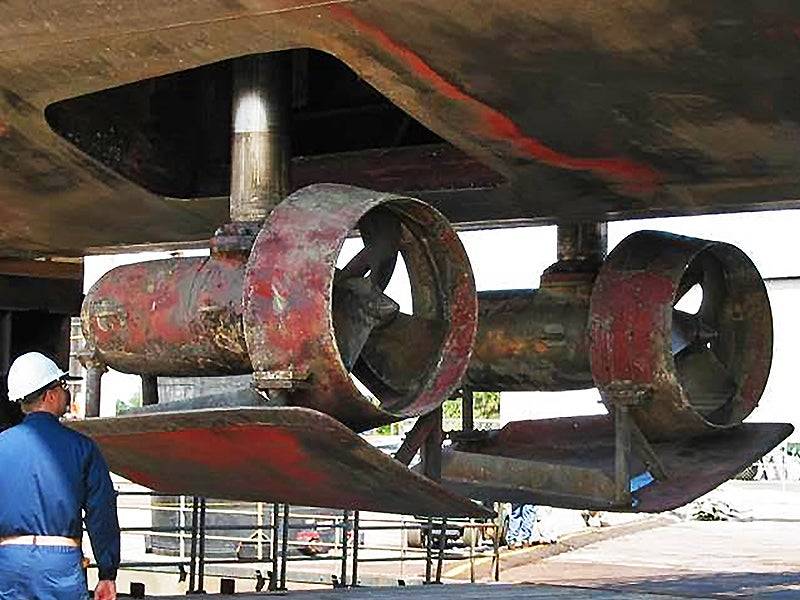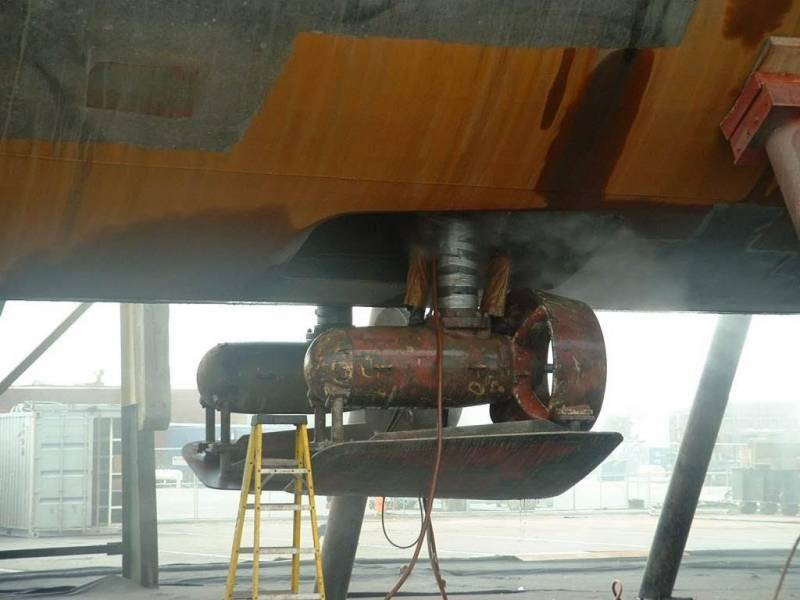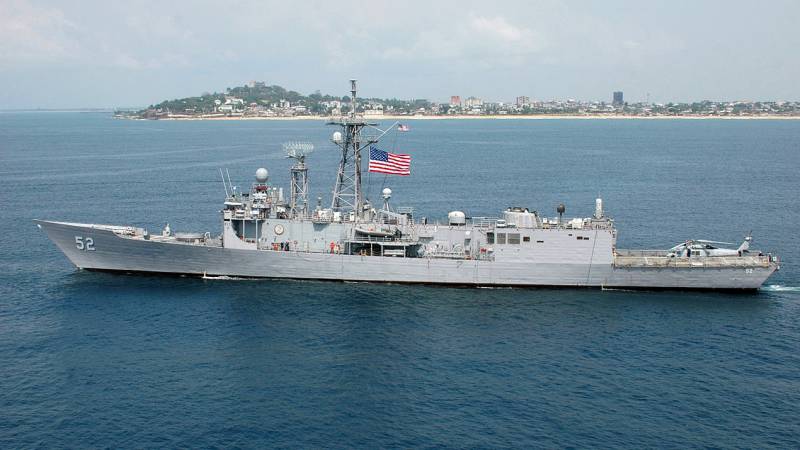Auxiliary propulsion of frigates of the type "Oliver Perry"

The WarZone edition continues excavations from stories weapons, and you are invited to familiarize yourself with another interesting result. This article was written July 5, 2020 by Tyler Rogoway and the notes are my own.
Feature unknown to the general public
“Oliver Perry-class URO frigates recently hit the last news (an article, I remind you, dated July 5, 2020), when it became known that the Navy expects to return to active service those of them that are still in the reserve and that have not yet been sent for scrapping. Such rumors began to spread after the well-known statement by President Trump about his intention to expand the combat strength fleet up to 355 units. These ships were hardly ever in the news, always somewhere in the bottom half of the core Navy, although their capabilities were well known. However, one of their features, although very innovative at the time, remained unknown to the general public - a pair of retractable rotary auxiliary propulsion.
Neither the Center for Naval History nor the Naval Systems Command (which is the largest organization in the US Navy responsible for the construction, repair and modernization and maintenance of ships) could not find a single photo or video of this system. The only photos we could find were posted seven years ago on a RC builders forum!

In official documents, this thing is called Auxiliary Power Pods (APPs). They can be extended from the hull and provide a speed of about 6 knots, receiving electricity from the ship's diesel generators. That is, the ship can move, albeit at a low speed, without the participation of the main gas turbine plant. Geometrically, they are located somewhere under the bow of the superstructure.
From the photo it follows that the APP can rotate 360 degrees. They were used as an additional tool for maneuvering, mooring, entering and leaving the port and could provide the ship with high maneuverability (that is, in such situations they served as what is now called a "bow thruster"). But above all, they could serve as a kind of large trolling engine, and in an emergency they helped to get, albeit at low speed, to a safe port. The presence of such an auxiliary vehicle made a ship with a single propeller shaft more reliable. It is also possible that the "acoustic handwriting" of the frigate when using the APP gave it advantages over the power plant of the conventional scheme.
Note. Here Mr. Rogoway used a combination of trolling motor, which sounds very strange when applied to a warship. Perhaps he is fond of fishing, because this term is just from the arsenal of an amateur fisherman.
The official response from Naval Systems Command was much the same. Auxiliary power unit (APP) on frigates of the O. Perry served two purposes. Since they had only one propeller shaft, they could be used to steer the ship in the event of a malfunction of the main power plant. They also assisted in moorings and in narrow spaces, giving the ship excellent manoeuvrability. The APP was introduced into the design of the entire series as part of a new shipbuilding program and has never been upgraded.
In general, these azimuth rotary nozzles were the forerunners of the Azipod, which are now often used as the main and only propulsion device, including on warships. This kind of "hybrid propulsion system" was in some ways ahead of its time, since the US Navy has only recently begun to use them in the surface fleet, albeit on a much larger scale.

The first USS Makin Island amphibious assault ship, commissioned in 2009, was the first hybrid propulsion and partial electric propulsion warship.
Note. There is a cunning and rather complex power plant with two gas turbines of 35 liters each. s., six diesel generators of 000 kW each and two AC propulsion motors of 4 kW, controlled through a frequency converter. Gas turbines turn on only at speeds of more than 000 knots, and before that the ship is a diesel-electric ship. Approximately 3% of the time the movement takes place on "electric traction", which gives significant fuel savings.
Arleigh Burke-class destroyers are being fitted with a similar hybrid propulsion system as part of a modernization program.
Note. In fact, only one of them received a hybrid SEU, after which this option was removed from the program - it turned out to be too expensive.
The most modern Zumwalts have a completely exotic power plant.
Note. Zumwalt is an electric ship in its purest form with a single power system, where the main diesel generators feed both propeller motors and supply electricity to all other systems of the ship. Apparently, this is exotic only for the military, because this principle has long been used on passenger liners.
Oliver Hazard Perry frigates are still in service with many navies. These countries have upgraded ships that were no longer needed in the United States by installing new systems weapons, radar, combat systems and even expanding the doors of helicopter hangars. Many of them will serve for decades to come.
As for the 355 program, we'll have to wait and see if these ships, with their fancy auxiliary power unit, return to service."
Note. As far as I've been able to gather information from the Internet, the Trump administration's plans for 355 ships are still plans. In 2021, the US Navy presented Congress with a shipbuilding program for the coming years, announcing that it intends to have 321 ships in service so far. But the Chinese brothers ... They have already reached the mark of 355 and are not going to stop.
A small digression
Frigates of this type were built from 1975 to 2004 as an inexpensive replacement for ships left in the fleet from World War II. The average price of one frigate turned out to be around $122 million, and they were tuned in the amount of 71 pieces. They were 138 meters long, 14 meters wide and displaced 4 tons. The power plant consisted of two LM100-2500 gas turbines with a total capacity of 30 hp. s., working on one propeller shaft with a variable pitch propeller, providing a maximum speed of 41 knots and a cruising range of 000 miles at a speed of 29 knots. For a long time, the ships were the backbone of the US Navy escort forces and managed to take part in several combat episodes.
In May 1987, during the “tanker war” in the Gulf, USS Stark received two Exocet missiles launched from an Iraqi fighter, but managed to cope with the damage and, after temporary repairs in Bahrain, reached its native port under its own power. The following year, the USS Samuel B. Roberts hit an Iranian mine but remained afloat. Although his power plant was completely out of order (both gas turbines were dislodged from their foundations), he was able to get out of the mined area using the same APPs. The frigate was then loaded onto the heavy lift vessel Mighty Seven 2 and transported to the States for repairs.
Repair took 13 months, after which the frigate returned to service. In the same year, USS Simpson, together with the cruiser USS Wainwright, sank an Iranian missile boat that dared to attack them. The ships were distinguished by great survivability. For example, in 2016, a frigate of this type was selected as a training target for the RIMPAC-2016 exercise, during which it was hit by four Harpoon missiles, two Hellfire missiles, one Maverick, a 900-kg Mark-84 bomb, and then a 225-kg GBU-12 guided bomb and, finally, a Mark48 torpedo, which broke the ship in half and finally drowned it.
In the late 1990s, the US Navy began the withdrawal of frigates from active service, transferring them to the reserve, and then cutting them into pieces. At the end of 2021, there were still 15 units in reserve.
Here is such a story. The excavations are ongoing.
Information